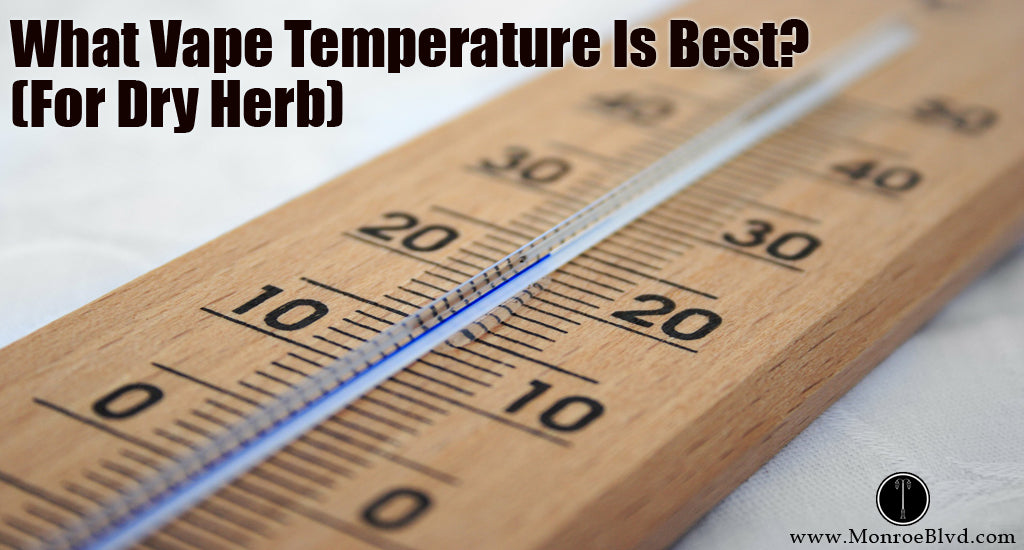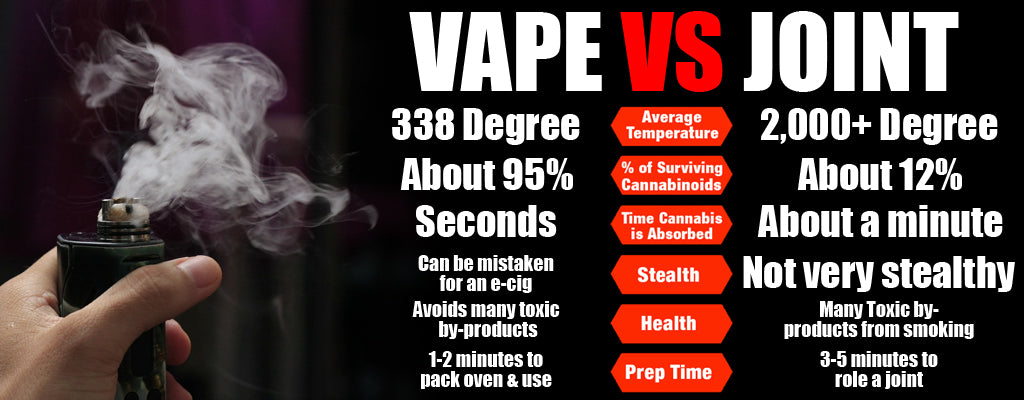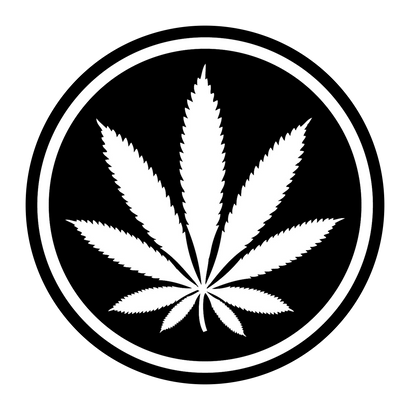
The Perfect Vape Puff: Balancing Temperature, Toxins, and Terpenes in Cannabis Dry Herb Vaporization
Consider this analogy: water boils at 100°C, but does that mean all fluids on Earth boil at the same temperature?
Of course not. Similarly, in cannabis, each cannabinoid has its own specific boiling point. The temperature at which these compounds vaporize can significantly affect the brain. Different temperature settings can also influence the release of specific chemical activators in varying proportions. In simple terms, consuming at higher temperatures may increase the likelihood of releasing toxins.
Optimizing Temperature for Cannabis Vaporization: Balancing Cannabinoid Release and By-Product Minimization
Different temperatures can release a variety of terpenes and cannabinoids. A study published by Taylor and Francis Ltd suggests that 230°C (446°F) is the optimal temperature for releasing the most THC and other cannabinoids. However, this temperature may also burn parts of the herb, potentially releasing harmful by-products (refer to the graph from the study for more details).
My research, including both online sources and personal experience, indicates that the effects of cannabis vary significantly between temperatures of 350 to 365°F and 420 to 430°F.
For a healthier consumption method using a dry herb vaporizer, it's advisable to lower the temperature.
Always remember, later you will have the leftover of AVB (Already Vaped Bud) that you can use to make edibles and more.
It's also worth noting that the leftover 'Already Vaped Bud' (AVB) can be used to make edibles and more.
Keep in mind that the optimal temperature might vary between different cannabis strains, and finding the right setting may require some trial and error. This approach is important to minimize the production of unwanted by-products.
Increasing the temperature from 338 F to 446 F during vaporization results in a higher yield of THC and total cannabinoids. However, this also leads to a greater production of by-products. The peak THC yield is observed at 446 F, suggesting a trade-off between cannabinoid extraction efficiency and by-product formation.

Exploring Optimal Vaporizer Temperatures for Desired Cannabis Effects: From Euphoria to Sedation
Vaping at lower temperatures often yields a 'smooth and linear' high, yet it might not lead to pronounced sedative effects. Typically, vaping at these lower temperatures can result in a more creative and cerebral experience. In contrast, temperatures exceeding 400°F are known to produce greater sedation and pain-relief.
So, what's the best temperature for you? That's for you to discover.
It's essential to understand that individuals use marijuana for various reasons, seeking different effects or medical benefits. The type of high one prefers may also depend on their specific intentions or plans for cannabis use.
Related article: 5 tips to smoke weed and be productive
Many people start their vaping session at the highest temperature setting, particularly when short on time. This method can quickly achieve desired effects and is sometimes preferred by users.
This approach is not just for those in a hurry. Setting the vaporizer to the highest temperature can also be useful for those seeking temporary relief from a stressful day or managing insomnia. However, for a euphoric, cerebral high with minimal body effects and no couch-lock – ideal for socializing, working, or watching a movie – lower temperatures, typically in the upper 300s Fahrenheit, are generally recommended.
As for best vape temperature... here is the deal...
Best Practices and Best Vaping Temp For Weed
Remember, as I mentioned earlier, there is no perfect vaping temperature. It largely depends on your tolerance and what you want to achieve during your session.
Here's the best practice I've observed to avoid combustion and maximize flavor:
- Pack your vaporizer with fresh herb and set it to a lower temperature, starting at around 340°F.
- Wait for 60 seconds to allow the herb to heat up.
- Vape at this temperature until there's no more vapor.
- Increase the temperature by 10 degrees and repeat steps 2 and 3. Continue this process until you reach 380°F, then conclude your session and turn off the vaporizer. Remember, the herb might still cook a bit even after the vaporizer is off, so continue taking puffs until there's no vapor left.
- Don't replace your herb yet. Terpenes release at various temperatures.
- For the second round, start at 360°F.
- Follow the same steps, but this time increase the temperature up to around 428°F. Then, stop your session and turn off the vaporizer.
By following this method, you should end up with a deep golden-brown AVB (Already Vaped Bud). Aim for this color; it shouldn't be too dark
Related article: How to Use a Dry Herb Vaporizer - Vaporizer Tips and tricks for Beginners
Pro tips

-
It's a common misconception, particularly among new users, to equate the absence of visible vapor with a lack of effect. While it's true that lower temperatures might not produce visible vapor, this doesn't necessarily imply an absence of effects. Instead, it's important to focus on the flavor profile and your physical sensations to gauge the effects of the cannabis. Vapor production alone is not a reliable indicator of the potency or effectiveness of the experience.
-
High-quality vaporizers like The Mighty, The Crafty and The Arizers models are known to provide approximately 20 puffs per session, or 40 puffs per bowl. It's important to remember that not every puff may be as satisfying as desired, but this doesn't mean you're not receiving any benefits. Even if it feels like you're not getting much, continuing to vape can still be beneficial, as active compounds may still be present. Persistence in vaping can lead to positive effects, so it's recommended to keep going.
-
At the end of a vaping session, the ABV (Already Been Vaped) herb should ideally have a consistent color throughout, flake by flake. Variations in color might indicate that full extraction wasn't achieved at the desired temperature. Therefore, stirring the herb inside the oven during the session is crucial for proper heat distribution and uniformity in the ABV's color. This stirring process enhances the extraction process and ensures consistency in the ABV.
-
Experimentation is key. Everyone's experience can differ slightly. This adds excitement and fulfillment to the process. There is no perfect temperature, and part of becoming a skilled vaporent involves discovering the temperatures that work best for you. Here are my findings, which you can use as a benchmark and adjust accordingly:
- 320-340°F: Incredibly flavorful, produces a good heady high.
- 345-385°F: A bit more sedative; thoughts tend to be deeper.
- 390-425°F: Couch lock effect.
- 430-460°F: Final couch lock phase; thoughts are very ADHD-like, often heavier and introspective, less suited for social settings.
-
Note that the ideal temperature setting may vary depending on your vaporizer. For example, I usually set my Mighty at 365°F, boosting it to 410°F when it weakens. However, with my Arizer Extreme Q, I rarely go below 410°F due to its pure convection system and the distance of the herb from the heating element, which results in a slightly cooler temperature. So, keep adjusting your vaporizer's temperature until you find your sweet spot."
-
Finally, r/vaporents for more dry herb vape questions, or reach out to me here.

More to consider
-
Health and Safety Considerations: While you touch on the release of toxins at higher temperatures, a more detailed discussion about the health implications of different vaping temperatures could be beneficial. This could include the risks associated with inhaling certain by-products at high temperatures.
-
Scientific Research and Studies: While you mention a study published by Taylor and Francis Ltd, additional references to scientific research or studies could lend more credibility to the claims about optimal temperatures and effects.
-
Cannabinoid and Terpene Profiles: A deeper dive into how different cannabinoids and terpenes affect the experience and how temperature plays a role in this could be insightful. This might include a discussion about the entourage effect.
-
Vaporizer Technology and Differences: Expanding on how different vaporizers (conduction vs. convection, for example) might affect the vaping experience and temperature settings could be useful, especially for beginners.
-
Subjective Experiences and Anecdotal Evidence: You could include more anecdotal evidence or user experiences to illustrate how different temperatures can lead to different effects.
-
Usage for Medical Patients: Addressing how medical cannabis users might approach vaping differently, especially in terms of temperature settings to maximize therapeutic benefits while minimizing side effects.
-
Environmental Factors: Mentioning how environmental factors (like altitude or ambient temperature) could influence vaping experience and temperature settings might be relevant for some users.
-
Maintenance and Care of Vaporizers: Tips on maintaining and cleaning vaporizers to ensure optimal performance and accurate temperature settings could be an added value for readers.
Stay toasty my friends.


